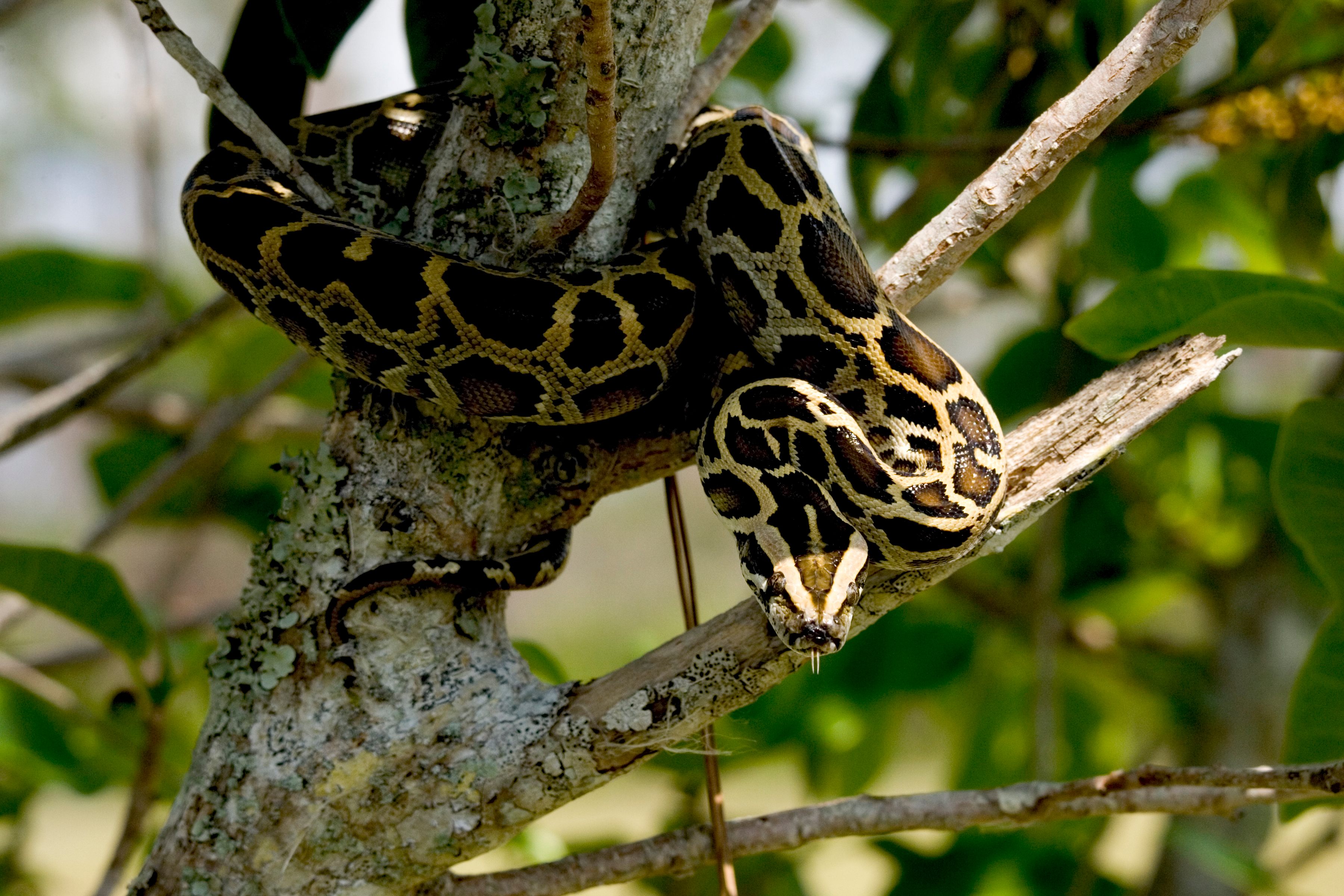How Escaped Pets Took Over Florida
When store-bought animals are released, they may go from pet to pest.

It was the end of November, 1929, and the holiday season was closing in. Maybe that’s why the pet store at 203 Tyler Street near Tampa, Florida, had recently ordered a shipment of monkeys, including a nursing mother and her baby. The shop was refreshing its winged offerings, too—a flock of canaries and parakeets had also just landed.
The store was sure to get loud and crowded—fast. But it was only a way station for these creatures, a stop between old homes and, presumably, new ones. To keep the inventory moving, the store placed an ad in the classified section of the Tampa Times. The monkeys were offered in the “Dogs, Cats, and Pets” column, beneath collie puppies and a wire-haired fox terrier described as “highly pedigreed, gentle, and affectionate.” The newspaper didn’t specify what species the monkeys belonged to, but whatever it was, they weren’t native to Florida, or anywhere in the United States—no monkeys are.
Across the country, and all over the world, families choose to keep pets that are wildly different from the ones that amble around naturally outside. In a new paper in the Journal of Applied Ecology, Oliver Stringham, a graduate student in ecology and evolution at Rutgers University, points to the trade in “exotic” pets as the primary way that many creatures slink, slither, or swing into ecosystems where they weren’t before.

Animals sold as pets sometimes end up outdoors when owners are forced to face smelly, inconvenient reality, or the realization that one’s apartment doesn’t grow like a pet python does, or the fact that they simply don’t want to be pet owners any more. That’s likely how red-eared slider turtles got into New York’s water and how goldfish took up residence in Australian rivers, not to mention big, active wild animals like monkeys. “Owners may underestimate the space and costs needed to keep such animals as they grow into adults,” Stringham said in a statement. Boa constrictors and reticulated pythons, for example, grow to over eight feet long. African clawed frogs and Russian tortoises can live 30 years or more, he added. “Not wanting to euthanize, owners may resort to releasing them instead.”
Stringham analyzed import, sales, and release data about 1,722 species of amphibians and reptiles brought to the United States between 1999 and 2016, and found that the “exotic” pets most likely to have been dumped over that period were those imported in the greatest number, sold for the cheapest prices, and having the greatest weight.
Florida has a particular mess on its hands. The state leads the country in number of introduced animal species. In a 2011 study synthesizing 147 years of data, Kenneth Krysko, herpetology collection manager at the Florida Museum of Natural History, attributed 84 percent of these introductions to the pet trade. “If the trends continue, it’s likely we will have more non-native species in Florida than native species,” Krysko told the museum’s press office at the time. “It’s really difficult to comprehend, but I believe it can happen.”
Here’s an overview of how some of Florida’s feral exotic pets have changed things—and what the state is trying to do to stop them.

Green iguanas
In South Florida, these spiky, scaly residents manage to live a life of both repose and destruction. They sun on seawalls and patios, and sometimes splinter concrete when they burrow. They slaughter hibiscus and bougainvillea, and then leave nasty surprises behind in pools. They scramble infrastructure and the electrical grid, too: They’re said to be one of the largest contributors to power outages, behind vegetation and squirrels.
Florida’s green iguana issue is thought to have started in the 1960s, when the lizards—native to Mexico and Central and South America—were set loose by owners or escaped during hurricanes. Adult iguanas have no natural predators in the state, and they lay dozens of eggs a year. There’s nothing there to hold them back.
“There’s no real way to come up with a valid estimate of the number of green iguanas in Florida. But the number would be gigantic,” Richard Engeman, a biologist for the National Wildlife Research Center, recently told the South Florida Sun Sentinel. “You could put any number of zeros behind a number, and I would believe it.”
To deter the lizards, the Florida Fish and Wildlife Conservation Commission encourages residents to engage in what they call “humane harassment,” such as stringing up windchimes or hanging some CDs, which become annoying when the sun strikes them. Trapping and relocating the lizards is a no-go (they could pass disease around), but Floridians are allowed to kill the lizards by decapitating them, firing a pellet gun at their heads, or piercing their brains. Researchers from the University of Florida are fine-tuning strategies for making these tactics as painless as possible.
Burmese pythons
The splotchy Burmese python, native to South and Southeast Asia, is one of the largest snakes in the world—and they’re ravenous. They entered Florida’s landscape a few decades ago, the same way that iguanas did, and have since more or less taken over the Everglades.
It’s now illegal to buy a Burmese python as a pet in Florida, but there are plenty already there, competing with gators for food, and sometimes even making gut-busting meals of them.
Local officials have periodically declared open season on the snakes, and invited hunters into the Everglades to take their best shots. It’s an unusual move, but the park’s superintendent, Pedro Ramos, told the Miami Herald that they’d exhausted more conventional options, such as trapping. “Maybe someday we’ll find a way to really get the upper hand,” he said.
That task could get even trickier, because new research by a team from the U.S. Geological Survey, published this month in Ecology and Evolution, suggests that the marsh-loving snakes have interbred with the similarly non-native Indian python, which usually live higher up, off the wetlands. Researchers believe that these offspring possess what’s known as “hybrid vigor,” which might allow them to expand their range. “In an invasive population like the Burmese pythons in South Florida,” lead author Margaret Hunter said in a statement, “this could result in a broader or more rapid distribution.” Good news for pythons, bad news for everyone else.

Rhesus macaques
And now back to those monkeys. Pet monkeys weren’t a new phenomenon in the 1930s. As far back in 1888, there was a guide for simian custodians that promised to teach aspiring owners how to choose a companion and build a simple cage. (The post-and-platform alternative, something like a birdhouse for monkeys, was apparently an inferior alternative. From it, the author Arthur Patterson promised, “your tenant may pelt you with refuse from his larder, defy your efforts to catch or pet him, and otherwise be objectionable.”) Similar to the way a guide for prospective puppy owners might offer some impression of the personalities of certain breeds, this handbook distinguished between monkeys that were “fuller of devilry” and ones that possessed an “effervescence of fun.” The author was sure that monkeys could become standard-issue pets and a favorite of fanciers, rather than “a haphazard whim of a few persons here and there.”

In fact, by the 1930s, released pet monkeys were already carving out a place for themselves in Florida ecosystems. That’s when a colony of rhesus macaques settled in Silver Springs Park, a tourist attraction between Orlando and Gainesville. They were allegedly introduced by design, as a tourist attraction, before they escaped their initial confines.
For decades, the sand-colored monkeys roamed wild, or something close to it, in the park, where they learned to dodge the jaws of alligators that were said to rear up to snap at them. Tourists flocked to watch them from boats slicing across the spring’s crystalline water.
Then, in the mid-1980s, state wildlife officials told the Associated Press that some of the primates had been scavenging in backyard garbage bins, gorging themselves in citrus orchards, and biting humans. Earlier this year, researchers from the Centers for Disease Control and Prevention found that the monkeys were also shedding DNA of a strain of the herpes virus that is transmissible to humans.
Bellies full of pilfered food were one thing; a potential public health issue was another. Wildlife officials have since pledged to boot the brigade from the grounds—though they’re not saying exactly how.
















Follow us on Twitter to get the latest on the world's hidden wonders.
Like us on Facebook to get the latest on the world's hidden wonders.
Follow us on Twitter Like us on Facebook